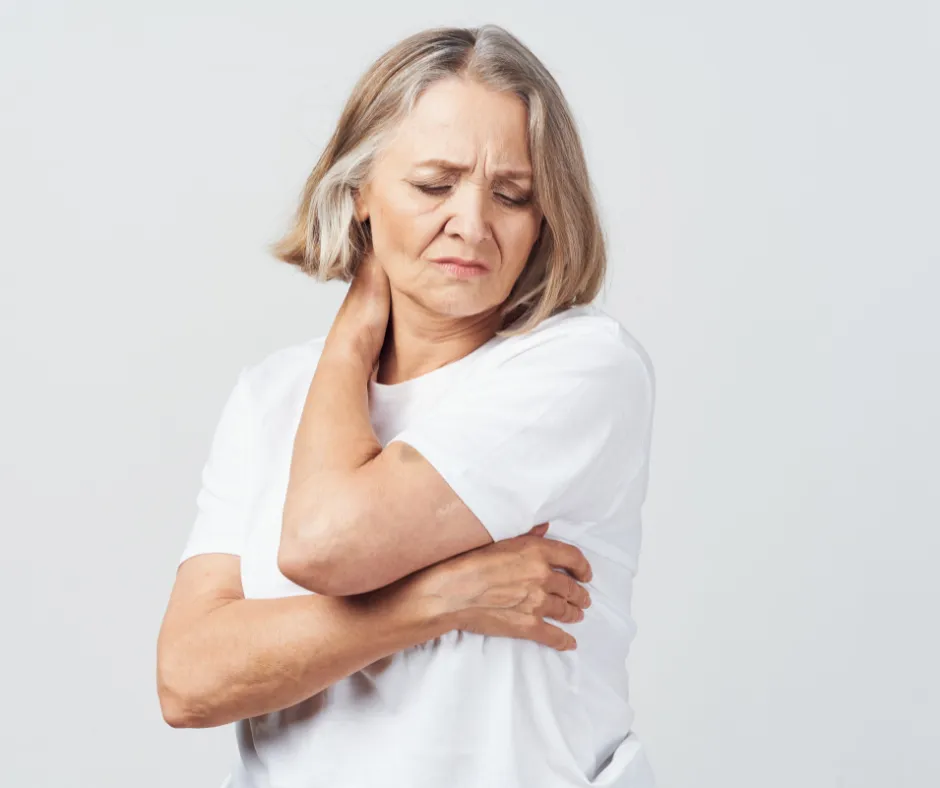Why aromatase inhibitors are important
Endocrine therapy is a very important part of hormone sensitive breast cancer treatment. Research has shown that it is an effective means for reducing recurrence and metastatic progression & growth. Despite the benefits, it can be difficult for some people to complete endocrine therapy due to the side effects. A naturopathic approach can help limit these side effects and help people to complete their therapy. While there can be several side effects associated with endocrine therapies, this blog post will specifically discuss joint pain from aromatase inhibitor drugs, such as anastrozole, letrozole, and exemestane. So, let’s dive in and explore this important topic!
Side effects are difficult, but we can help
It’s estimated that 33-74% of people using aromatase inhibitor drugs experience joint pain. Often times it is the primary reason why someone chooses to stop taking their medication. I want to acknowledge how difficult these side effects can be, especially if you were diagnosed with breast cancer at a younger age. Pain and discomfort can change the way that you live your life, but you don’t have to suffer through these side effects by yourself and there are integrative approaches that can help.
AIMSS and aromatase inhibitor drugs
Aromatase is an enzyme that converts the testosterone in the body to estrogen. When people take aromatase inhibitors, it effectively decreases the amount of estrogen in the body. Estrogen helps protect the joints, bones, and reduces inflammation.
The joint pain that develops from aromatase inhibitors is part of a larger condition called “Aromatase Inhibitor-Associated Musculoskeletal Syndrome” or AIMSS. It refers to not only the joint pain, but the bone loss that can happen from using aromatase inhibitors. The musculoskeletal symptoms are often described as joint pain (arthralgia), muscle pain (myalgia), joint stiffness and tendon issues. It may include decreased strength and/or carpal tunnel syndrome in some individuals. Onset of joint pain is typically 6 weeks to 12 months after starting an aromatase inhibitor.
If you’ve ever wondered which aromatase inhibitor is best with the least side effects, well the answer is – it depends! Switching to a different aromatase inhibitor is worth discussing with your doctor because it has been shown to help with AIMSS in some cases.
Naturopathic approaches
Stay hydrated
While it certainly may not solve all issues with joint pain, making sure you are well hydrated is an excellent first step. Even being mildly dehydrated can increase your perception of pain. Hydration also plays an important role in joint lubrication and health. I know this sounds simple, but don’t underestimate how the little things can add up to make a bigger difference!
Acupuncture
If you are suffering from joint pain due to aromatase inhibitors, I want to encourage you to give acupuncture a try! A 2023 systematic review compared several interventions for aromatase inhibitor associated joint pain—acupuncture, sham acupuncture, multicomponent herbal medicine, exercise, duloxetine, vitamin D, omega-3 fatty acids, physical therapy, testosterone. Acupuncture was the highest ranked intervention of the group!
While a single session of acupuncture may make you feel better for a few hours or up to 1-2 days, it is important to go regularly to get longer and more lasting relief. It is common for people to go 1-3 times a week for 8-12 weeks.
Exercise
Joint pain can make you want to move less, but I want to encourage you to stay active! A 2015 study looking at 121 breast cancer survivors with aromatase-inhibitor arthritis symptoms found that exercise improved symptoms. The study enrolled women who were getting less than 90 minutes a week of aerobic exercise and had an equal or greater score of 3/10 on a 0-10 scale, where 10 is highest pain for pain severity. The study group increased their aerobic exercise to over 150 minutes a week and added strength exercises. The exercise group reported a significant decrease in pain severity after 12 months. The participants with the worst level of pain on enrollment saw 29% decrease in pain scores, while the group that didn’t increase exercise reported an increase in pain severity.
Kineso Taping with Therapist
Kineso Taping is where a special form of tape is applied to the skin to help support the movement of the lymph, to decrease inflammation and pain. It is offered by various health professionals, but you can find someone certified at this website.
A Spanish pilot study looked at the effects of Kinesio taping in 40 breast cancer survivors receiving either Tamoxifen or aromatase inhibitors. Three sessions of taping were used over a period of at least 5 weeks. By the end, significant improvements were seen in the participants’ subjective experience of pain, fatigue, and quality of life measures.
Tart Cherry Juice Concentrate
Tart cherry juice concentrate is another option that has been shown to decrease joint pain. It is also a natural source of melatonin, which can help with sleep. If you experience joint pain that disrupts your sleep then this may be a good option to try.
A 2021 study looked at 46 participants that had been on an aromatase inhibitor for at least 4 weeks and gave some of them 1 ounce of tart cherry juice concentrate in 8 ounces of water for 6 weeks. They found a 34.7% mean pain decrease with the tart cherry concentrate versus 1.4% in those that didn’t receive the tart cherry.
Evidence for correcting Vitamin D3 deficiency
Vitamin D is really important for a variety of health outcomes, including joint pain. Many people are vitamin D3 deficient (levels < 20 ng/mL) or insufficient (levels <30 ng/mL). Unfortunately, this has been associated with increased joint pain and fatigue in women taking aromatase inhibitors. Additionally, vitamin D3 deficiency has also been shown to play a role in osteoporosis, which is a potential side effect of aromatase inhibitors.
The good news is that this can be a relatively simple thing to address. I highly recommend working with a health professional to measure your levels of vitamin D3 and to get an individualized supplement recommendation, if necessary. If you are vitamin D3 deficient or insufficient, it is important to have your vitamin D3 levels rechecked to make sure you are absorbing the supplement properly and getting enough, but not too much.
It is possible to develop vitamin D toxicity at high levels taken over a long period of time. Since it is a fat soluble vitamin, the vitamin D3 levels are slow to decline once you stop the vitamin, so toxicity effects may take longer to resolve. More often, people don’t absorb their vitamin D3 supplements well. It is important to take it with a meal that has fat and/or take a liposomal or micellized form that is easier to absorb. People with fat malabsorption issues are more prone to vitamin D deficiency and insufficiency.
OPERA study
A phase II clinical study evaluated 46 participants for use of a supplement that contained alpha-lipoic acid, boswellia, bromelain and MSM (methylsulfonylmethane). They found a significant reduction in joint pain using the supplement, with 10-21% of participants experiencing complete resolution of joint pain!
I know that this news may inspire you to hop up right now and look for these supplements. However, some of the supplements used in this study may interact with prescribed medications, over-the-counter medications, and/or certain health conditions. For your safety, check with your doctor and/or pharmacist before starting supplements.
An individualized approach to pain management
We work with people taking aromatase inhibitors to come up with non-hormonal strategies to relieve their joint pain. We typically recommend individualized supplements based on what is safe and appropriate for their individual situation. If you are suffering from joint pain or other symptoms caused by aromatase inhibitors, I encourage you to contact our office to see if we can help. The beauty of integrative care is that you are more likely to complete your treatments because you experience less side effects. If you are considering stopping your endocrine therapy, please contact us to see if we can help you stay on track with your oncologist’s treatment plan while getting relief from your side effects.
BONUS!
Don’t miss out on our Natural Approach to Joint Pain Workshop in January. I’ll be partnering with local physical therapist, Dr. Shawna Townsend PT to teach you a variety of techniques and natural approaches to help you do more of what you love with less pain. Learn more here!
https://www.ncbi.nlm.nih.gov/pmc/articles/PMC6467469/
https://pubmed.ncbi.nlm.nih.gov/26785699/
https://pubmed.ncbi.nlm.nih.gov/25452437/
https://pubmed.ncbi.nlm.nih.gov/33586504/ and https://pubmed.ncbi.nlm.nih.gov/36535489/
https://pubmed.ncbi.nlm.nih.gov/34275765/
https://pubmed.ncbi.nlm.nih.gov/35666314/
https://pubmed.ncbi.nlm.nih.gov/29890985/
https://pubmed.ncbi.nlm.nih.gov/19125120/
https://pubmed.ncbi.nlm.nih.gov/19655244
Katrina Bogdon, Naturopathic Doctor
Katrina Bogdon, ND graduated from a four-year accredited naturopathic medical school in North America. She completed a two-year residency in naturopathic oncology and served at Cancer Treatment Centers of America in Tulsa, OK for 5 years. She is trained to work integratively with conventional oncology care and also provides care for people without a cancer diagnosis.





